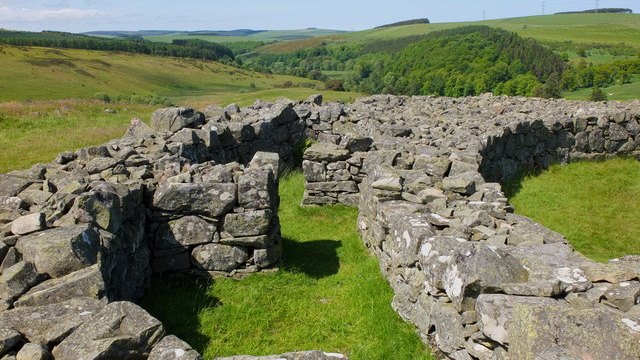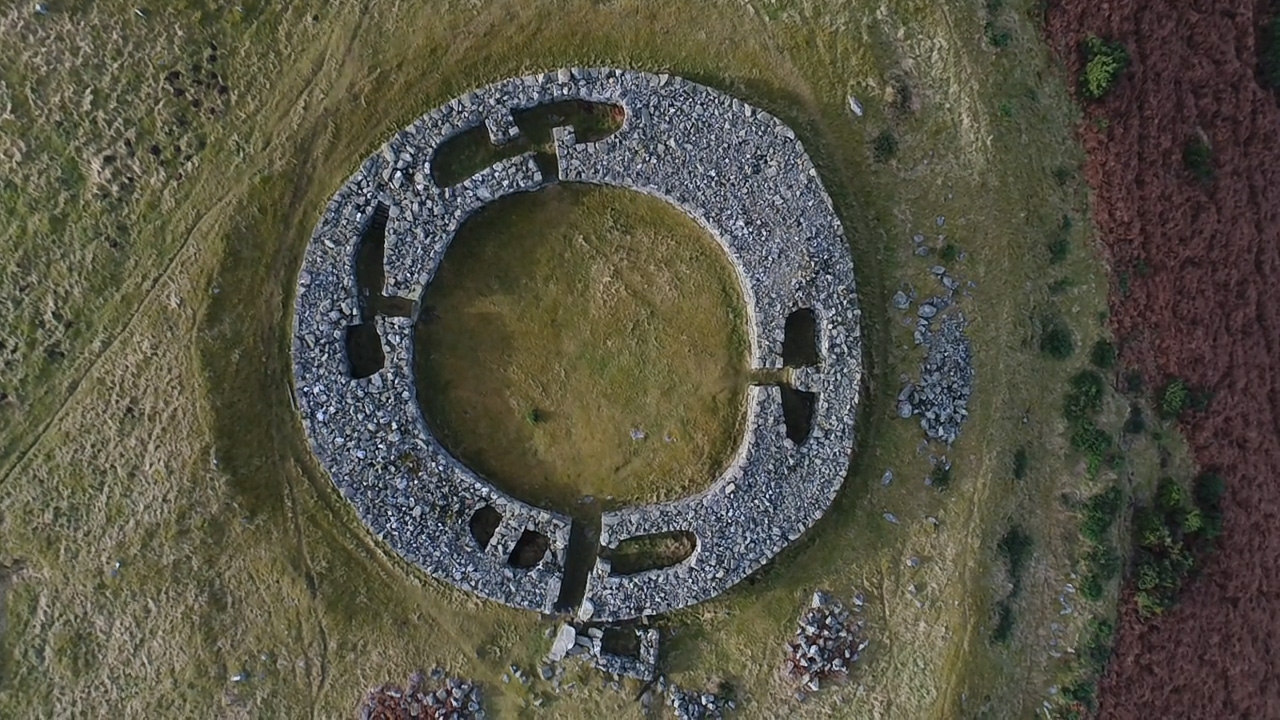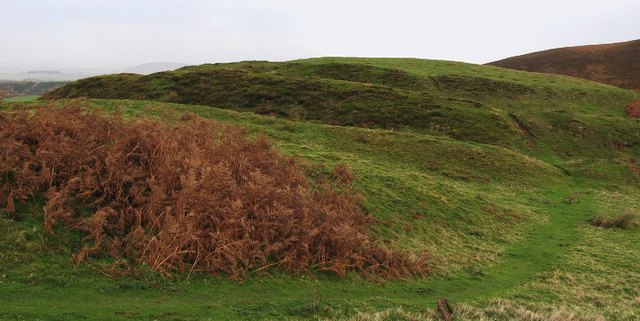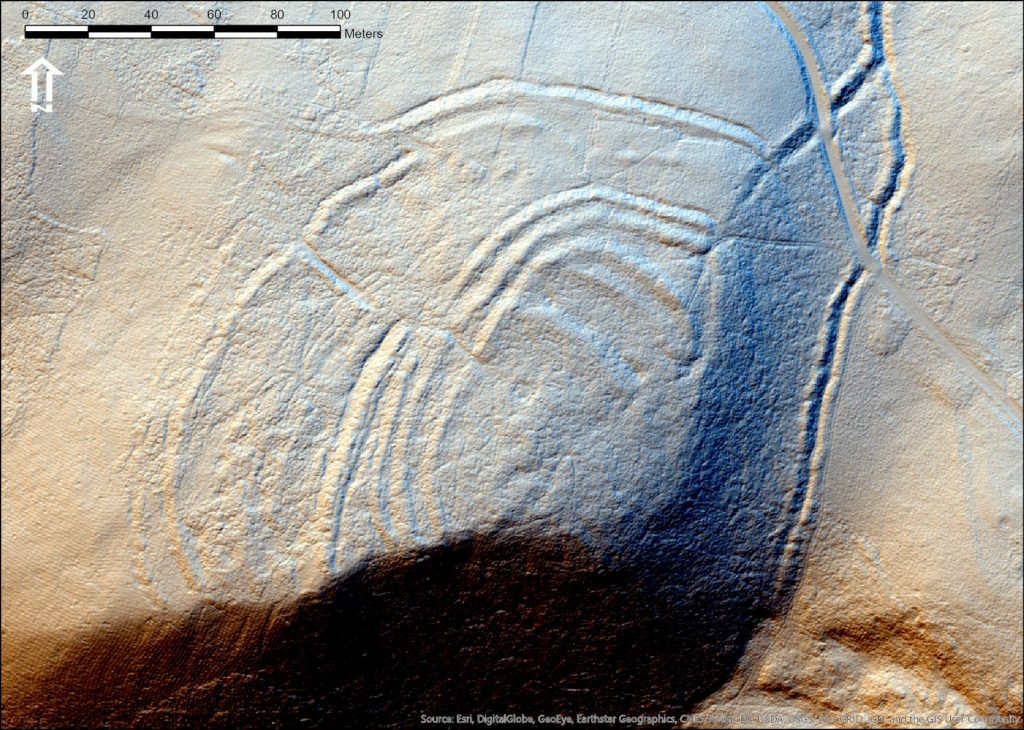A desire to make an impression was just as much a feature of prehistoric life as it is today, and Iron Age communities were certainly not shy of making a statement. Monumental architecture dating to the Iron Age (c. 500 BC to around AD 300) includes hillforts and brochs.
Edin’s Hall Broch
Brochs – massive, tapering drystone towers – were clearly designed to impress. Brochs are abundant in northern mainland Scotland and across the western and northern isles, but very few are found south of the central belt. However, an unusual lowland example can be found perched high above the Whiteadder on the steep north-eastern slope of Cockburn Law: Edin’s Hall Broch. The name may derive from Edwin, king of Northumbria from AD 613 to AD 632/633; or to Etin, a fearsome giant of Scottish legend; or even to the Norse god Odin. At any rate, the name suggests that the broch was seen as the stronghold of a powerful person and, indeed, that was the intention of its Iron Age builders. Though Edin’s Hall’s walls survive to only a few feet now, it would once have towered high into the air; the tallest surviving broch is at Mousa on Shetland, which stands at over 12m. each broch was probably home to an extended family group, with the internal space divided into discrete activity areas across multiple storeys.


At first glance, the broch appears to sit within a hillfort demarcated by ramparts and ditches, with a complex of at least 13 structures clustered to the south-east. However, the broch is certainly later in date than the fort and most likely represents reuse of a much older site. The chronological relationship between the broch and the surrounding settlement remains, though, is less clear: it is not known which was built first, or even if they were occupied at the same time. Nonetheless, the broch represents a striking example of monumental prehistoric drystone architecture, designed to impress and built to last. We will probably never be able to say why this unusual structure was built here in the Borders, so far from the main group of similar structures in the north and west; perhaps the broch was a symbol of northern resistance in the face of an advancing Roman army?

Brochs were a source of great intrigue to the antiquarians of the 18th and 19th centuries, and Edin’s Hall was no exception. Noted genealogist John Stuart LLD (1813-1877) was quite aggrieved by the flaws he found in the various written descriptions of the broch, from wildly inaccurate dimensions to reports of carvings on every stone! As late as 1870, General Lefroy claimed that “the earthworks round the castle are on a scale beyond the efforts of a very primitive people”, attributing the site a date no earlier than the seventh century AD. Underestimation of prehistoric peoples’ abilities was common in recent centuries, and is it only through new excavation and continued re-examination of both the evidence and our own biases that we are able to overcome our limitations in understanding the lives of people of the past.
Hillforts
The hilltop location of Edin’s Hall broch was prime real estate: long before the broch was built, a community had chosen the same site to build a hillfort. Over 400 hillforts or possible hillforts are known in the Scottish Borders today, making it one of the most densely concentrated distributions of hillforts in Europe. East Lothian has only around 90, but this number includes some stunning examples such as Chesters and Traprain Law. It is very likely that in the earlier Iron Age in south-east Scotland, almost everyone lived in, or had close ties to, a hillfort.

Traditionally, hillforts were believed to be primarily defensive in nature, but this interpretation was largely borne of the belief that prehistoric tribes were bloodthirsty warmongers, frequently attacking one another. While disagreements and indeed battles were certainly a feature of Iron Age life, they are unlikely to have been an everyday occurrence. Moreover, the very size of some hillforts would render them almost impossible to defend. The largest hillfort in the study area, for example, is Duns Law, where the ramparts enclose an area of around 2.5 hectares. How many people would have been required to keep the perimeter safe if it were under attack? Though they may appear strongly defended, they were also intended to astound and intimidate.
As the name suggests, hillforts are found on summits and these defensive locations were doubtless preferred, but the pattern we see today is also a result of differential survival. Similar sites most certainly existed on lower slopes and river terraces but have been lost through agricultural activity in the two millennia since their occupation. Bunkle Edge, an 8km long ridge running broadly WSW-ENE between the Eye Water and the Whiteadder, has at least five possible forts distributed along its ridge. What seems like a concentration of prehistoric occupation and activity is more likely just lucky survival of sites on higher ground.
The Hopes Fort
Perhaps the most complex fort within the study area is the Hopes, which occupies around 2.5ha on the summit of one of the north-west spurs of Bleak Law. The ground drops sharply away to east and south so the defences are concentrated on the west and north sides of the fort. The inner enclosure, right on the summit, is skirted to the west and north by a broad outer enclosure, with entrances through the ramparts being at the north-west and north-east.

A linear earthwork with double banks and a central ditch runs alongside and past the fort to the east, seeming to approach the entrance at the north-east, but its relationship to the fort itself is unknown. The aerial LiDAR data reveals the presence of a timber stockade line in the interior of the fort, a feature that is difficult to discern on the ground and a remarkable survival of timber construction.
The array of ramparts and ditches at the Hopes make it highly likely that the fort is a complex, multi-period site and while it is possible to identify areas where certain features clearly overlie others, the site’s chronology cannot be easily picked apart without excavation. Its origins are likely in the early Iron Age, around 2500 years ago, but it certainly went through numerous refurbishments, extensions and rebuilds, shown by the defences becoming more and more elaborate.

